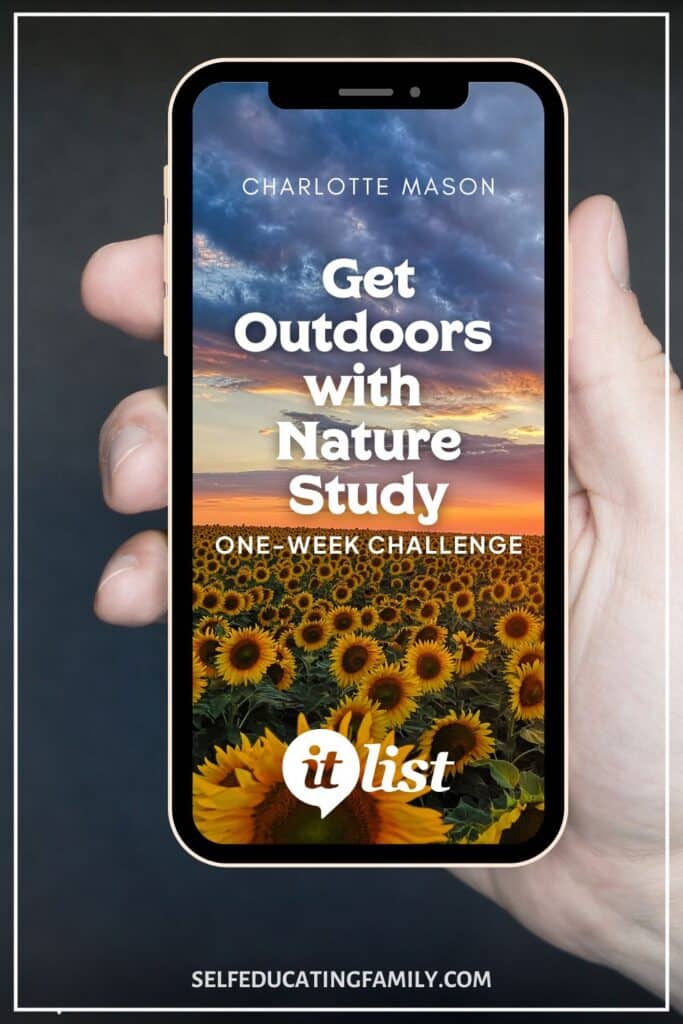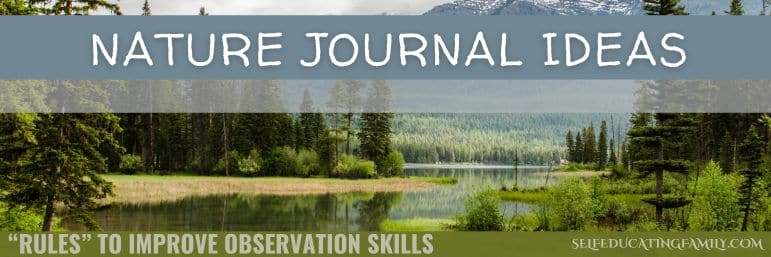Learning Outdoors
What’s Inside: For learning outside, do you find it hard to get outside in nature with your kids? Get outdoors with these 6 easy nature activities to start learning outside. With a bit of pre-planning, nature study can help your kids to hone their observation skills and send them on the way to becoming self-learners.
6 Options for Getting Outdoors to Learn
- 15-minute walk
- Backyard Exploration
- 1-hour walk
- 2-hour base camp
- ½-day Nature Hike
- Field Trip
How Much Time Do You Have?
I’ve categorized these 6 options by time. How much time can you spend today for outdoor learning? What about tomorrow? What about the rest of this week?
If you PLAN to spend some time outdoors, you are more likely to get out there.
Here’s a description of what I mean by these 6 options.
15-minute walk
This is the perfect option for when you need a break. So put on the coats & shoes, and head out the door for a walk around the block.
Tips:
- Encourage quick “getting ready” to step outside by subtracting the time from the walk.
- Go out and back – for half of your time, walk in one direction, then when half your time is up, turn around and go back. This is especially good if your block is too large to complete in a short amount of time.
- Experiment with “the silent” observation walk – no talking, just walking. When you get back, discuss what you saw.
- Try counting your observations – how many birds of each type did you see? How many prairie dogs? Or regular dogs? What kinds of trees grow near you? How much snow melted since last time you were out?
- Announce a theme at the start, like “Let’s find what’s changed since we have been here last” and have the kids make observations as you go.
- In general, you might not use your journal to record anything. If your child is interested in weather or if that’s your focus topic, then you may want to record the date & weather conditions you observed after you get back.
- 15 minutes is arbitrary – the point is a very short walk that is a quick break from whatever you were doing. It should leave you all refreshed.
The VERY short walk should leave you refreshed.
Backyard Exploration
If you can’t leave the house, try this option. If you don’t have a backyard, do you have a nearby green area? Or a balcony? How about an aquarium? Or indoor plants? See if you can find a very close area with some nature in it.
Tips:
- Use your nature journal: both words and sketches
- Record “up close” observations
- Use your focus topic to hone in on something going on in your yard – e.g. if you are studying insects, get a shovel and hunt for some insects
- Sketch what you can, even if you don’t know what it is.
- Write down questions that you want to answer later when you go back inside.
- Use lists to record things of interest – e.g. types of trees in my backyard, birds at the birdfeeder, shadow length of the flag pole at noon on different days of the year, rainfall, etc.
Backyard Exploration is a great way to practice nature journaling and observation skills.
1-hour walk
This is the option for a short walk. Longer than around the block, but shorter than a whole afternoon.
Tips:
- An hour is enough time to work in your journal and walk.
- You might want to drive to a local walking trail.
- Bring water.
- Bring a first aid kit in your car at a minimum.
- If you have littles, bring snack even though it is a short walk.
- You can walk a bit, then journal at a spot, then return.
- Substitute “bike” for “walk” – You might want to bike for 20 minutes on a trail, spend 20 minutes with your nature journal, and then 20 minutes back.
- Instead of “walk”, drive to a local picnic/nature area and sit at a picnic table with your journals. Use the picnic table as a mini-base camp to keep coming back to.
The short walk can combine walking and journaling.
2-hour base camp
The “Base camp” is where you set up your journals and stuff and your kids explore nearby (within sight or age-appropriate distances). 2 hours is enough time to soak up nature, record observations in your nature journal, and do some walking.
Tips:
- Drive or bike to the area.
- Set up a “base camp” with your journals and supplies.
- Bring water and snack.
- Great option for including other families.
- Establish boundaries for exploration. Assign teams of buddies or older children keeping an extra eye on the younger ones.
- Change it up occasionally by offering challenges to your kids – nature scavenger hunts, distance games, etc.
- You can spend the first hour in official nature study and the second hour in lunch and social free time.
- 2 hours is also enough time for a reading selection on your topic. Keep outdoor reading short – only as long as your audience can focus.
Use a “Base Camp” as a center of activity. Great option for joining with another family.
Half-day Nature Hike
When you say half-day, you are committing to a full afternoon or morning. 4-6 hours.
- Be clear on where you are going. Have a map or trail map.
- Tell someone where you are going.
- Dress appropriately.
- Figure on the weather changing. Plan accordingly.
- Bring food, water, and first aid kit. Everyone should carry their own water, unless you plan on carrying them – then you can carry their water too.
- Bring your nature packs. Everyone should carry their own nature pack if they are big enough.
- The Nature hike can often have its own purpose – e.g. if you hike in to a waterfall, the point is to see the waterfall. Unless you go to the ones near me which are seasonal. It can be a water trickle in that case, or sometimes just some dry rocks.
- If your hike has a major destination or purpose, plan on stopping there for some time to eat and record observations in a journal.
- A Nature hike is a good time for compass drills and map work. Also, it’s good for recognizing trail markers and distance games if the trail distances are marked. Lots of fun things you can bring on a hike.
Lots of adventure and nature opportunities can occur on the nature hike.
Field Trip
A field trip is very specialized and often takes a full day.
Tips:
- Research or plan ahead of time to set up your field trip.
- Bring food and water.
- Dress appropriately.
- Schedule your field trip on the family calendar.
- Don’t tell the children who can’t read the calendar that you have a field trip coming up. They don’t have the brain power to wait and you will get more questions like “Are we going to the zoo today?” twenty-seven hundred times before you go.* *This is a scientific fact and not just experiential, although I think I made the mistake of announcing something 3 weeks ahead of time when I was plagued with questions.
- If you need ideas for nature study field trips, download my free guide.
Field Trips are a great opportunity for learning. Download my free Field Trip Ideas List
Learning Outdoors
You can use this list of “time-based” ideas for nature study to schedule getting outdoors for your learning time based on how much time you have on a particular day.

Keep Learning
If you would like more detail on working with a nature journal, then try my One-Week Challenge: Get Outdoors with Nature Study.
Get the One-Week Nature Study Challenge!
I will guide you through the routines and skills you need for your nature study journey.
Related Posts
More Resources
- Sonlight Field Trip Ideas
- Field Trip Ideas | Temecula Blogs
- Homeschool Field Trip Ideas | The Homeschool Mom











